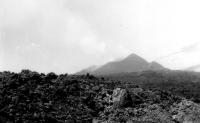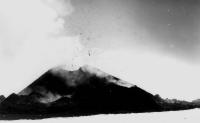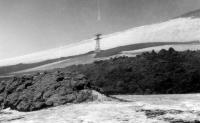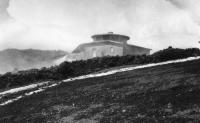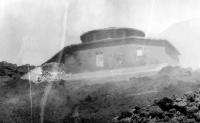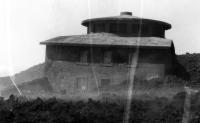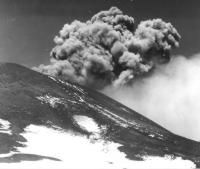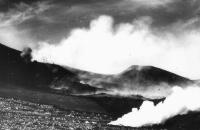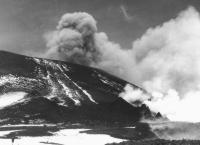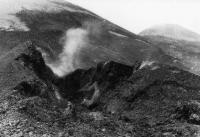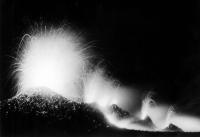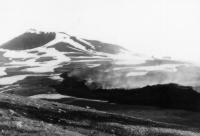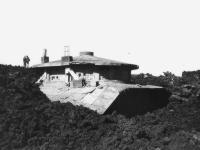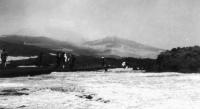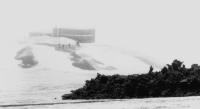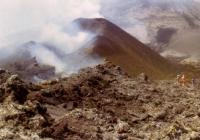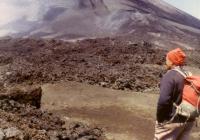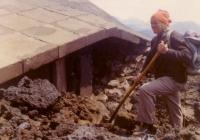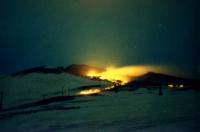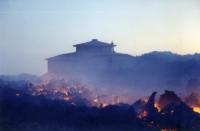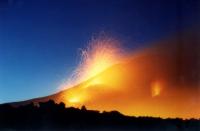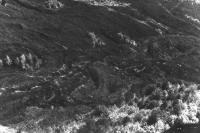 |
Map
of the 1971 lava flows
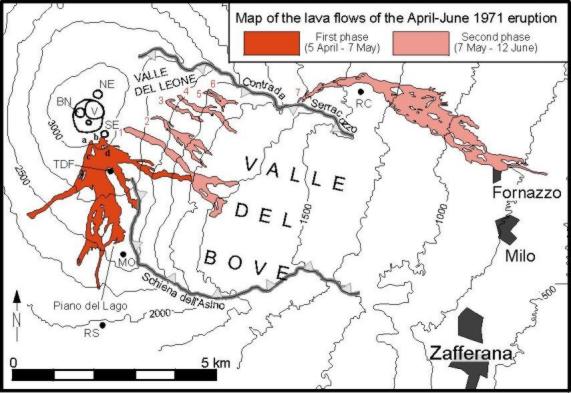
|
Eruptive
fissures of the first phase of the eruption are labeled a, b,
c, and d; fissures of the second eruption phase are numbered 1
through 7. NE=NE Crater; V=Voragine; BN=Bocca Nuova; SE=SE Crater
(degassing pit of the second eruption phase); TDF=Torre del Filosofo;
MO= Montagnola; RS=Rifugio Sapienza; RC (south of largest phase
2 flow)=Rifugio Citelli. Click on image to get large version.
|
Before
the 1971 eruption
Three months before the 1971 eruption, mild
Strombolian and effusive activity is continuing at the NE Crater,
which is in continuous eruption since January 1966. This photo,
taken by Giuseppe Scarpinati from Acireale on 16 January 1971,
shows a gas plume rising from the crater (whose cone is visible
as a black hump to the right of the snow-covered main summit cone),
and dark lava flows extending from the NE Crater to the north
(right) and east (black lobes on the near side of the cone).
|
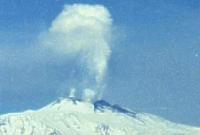 |
Stage
1: Activity from new vents on the SSE and SE base of the main summit
cone,
5 April to 7 May 1971
The following
series of b/w photos was taken by Carmelo Sturiale (+1988), at that
time volcanologist at the University of Catania. The photos were kindly
provided by his son, Giovanni, now at the Dipartimento di Scienze Geologiche
of the University of Catania. Many of these photos have never been published
before.
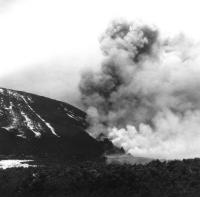 |
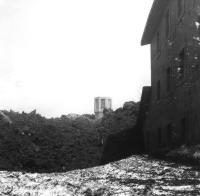 |
|
Left:
Eruptive activity at the "Eastern vents" at the southeastern
base of Etna's main summit cone (visible at left), in April 1971.
A number of small scoria cones and hornitos are building at the
eruptive vents.
Right: Lava is encroaching on the Observatory building (at right).
The burial of the building is proceeding at agonizingly slow speed,
with successive lava surges piling up ever higher around the Observatory.
|
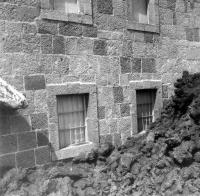 |
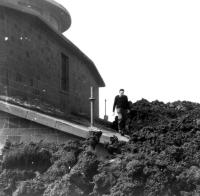 |
|
Two
more photos showing the burial of the Etna Observatory under the
lava of the 1971 eruption. Person in the photo at right is Cucuzza-Silvestri,
at that time Professor of Volcanology at Catania University.
|
The
following photographs, taken by Carmelo Sturiale, were in part published
in the report on the 1971 eruption by Romano et al. (1972) that appeared
in the Atti dell'Accademia Gioenia di Scienze Naturali in Catania. The
scans were made from the original prints of the photos.
The next three photos are from the photographic collection of Carmelo
Sturiale and show a later stage of the initial phase of the 1971 eruption.
The
four photos below were taken by Giuseppe Scarpinati, Italian member of
the Paris-based Association Volcanologique Européenne (LAVE), who
climbed Etna hundreds of times since the 1950's and documented most eruptions
since the 1960's photographically.
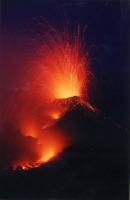 |
A
cluster of cinder and spatter cones ("Observatory vents")
is growing during the first phase of the 1971 eruption near the
southeastern base of the main summit cone. Photo was taken in mid-April
1971 by Giuseppe Scarpinati
|
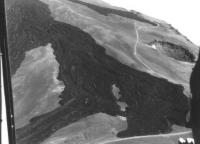 |
|
 |
|
Photos
taken by Carmelo Sturiale after the end of the 1971 eruption, showing
the lava flows emitted during the first phase of the eruption and
other effects of the activity in the summit area.
Left: Aerial view of lava flows covering the Piano del Lago immediately
N of the Montagnola. The conspicuous pit crater near right margin
of image formed during the 1792-1793 flank eruption and is known
as the "Cisternazza"
Center: Looking down from the SE rim of the Central Crater towards
the W rim of the Valle del Bove. The pit in the foreground formed
during the second phase of the 1971 eruption (see below)
|
Stage
2: Activity from fissures in the W part of the Valle del Bove
and at Contrada Serracozzo, near Rifugio Citelli (ENE flank)
|
The
two photos at right were taken by Carmelo Sturiale during the second
phase of the 1971 eruption.
Top: On 7 and 8 May 1971, new fissures open across the northwestern
part of the Valle del Bove towards its northern rim. The most productive
of these fissures lie outside the Valle del Bove near the Rifugio
Citelli. One of these fissure vents is shown in the photo at right,
emitting fluid, degassed lava, which flows through forests towards
the villages of Fornazzo and Sant'Alfio.
Bottom: Lava is slowly burying a bridge near the village of Fornazzo.
Cultivated land in the adjacent areas is also destroyed by the lava
which threatens to destroy Fornazzo and the nearby village of Sant'Alfio.
|
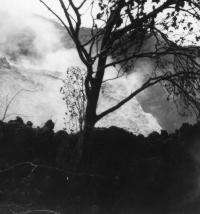
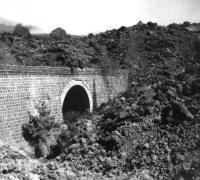 |
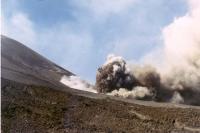 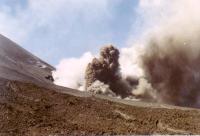 |
During
the second stage of the 1971 eruption, eruptive fissures propagated
downslope northeastwards across Valle del Bove and beyond, into
the Contrada Serracozzo. In mid-May, while the flank eruption seriously
threatened villages and cultivated land on the eastern flank, a
new vent opened on the SE base of the main summit cone (visible
at left in both photographs), apparently serving as a degassing
valve to the flank eruption. The activity at this vent ejected only
old fragmental material. Seven years later, in April 1998, magmatic
activity occurred at the same site, initiating the vigorous life
of what became the SE Crater (or SE Cone). These photos were taken
by Carmelo Sturiale.
|
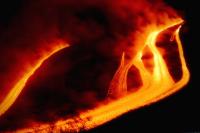 |
Two
spectacular nocturnal views of the lava flows issuing from the eruptive
fissure near the Rifugio Citelli, taken by Giuseppe Scarpinati
|
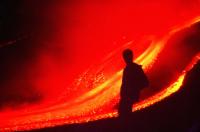 |
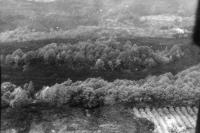 |
|
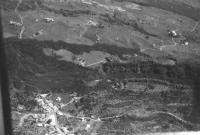 |
|
Aerial
views (by Carmelo Sturiale) of lava flows extending from the Contrada
Serracozzo/Citelli vents towards the populated and agricultural
areas near Fornazzo and Sant'Alfio. The lava has eaten through dense
forests (left and center). Right photo shows the northern margin
of the village of Fornazzo at lower left, and the lava flows, which
have narrowly missed the village, extending through the narrow stream-cut
gorge of the Vallone Cava Grande. One arm of lava has cut the road
leading from Fornazzo to Sant'Alfio (lying outside the photo at
right)
|
 |
Aerial
view of the ENE flank of Etna after the end of the eruption. N rim
of Valle del Bove (Contrada Serracozze) is in the foreground, culminating
at right in the Pizzi Deneri. W slope of Valle del Bove is in center-left
part of the photo, with dark lava flows emplaced at the beginning
of the second stage of the 1971 eruption, before activity migrated
out of the Valle del Bove to near Rifugio Citelli (out of photo
at right). Summit cone complex has the main summit cone at left,
and the smaller NE Crater cone, with the "Nordestino"
(a large hornito active in 1970) at right. Photo Sturiale
|
|
Aerial
view taken by Sturiale after the end of the 1971 eruption, showing
the eruptive fissures at the Contrada Serracozze which delivered
the destructive lava flows of the second phase of the eruption.
Lava effusion occurred from two fissure segments indicated as white
bars. Behind the crest of the Contrada Serracozze, in the upper
third of the photo, lies the Valle del Bove, on whose floor several
dark lava flows erupted during the initial stage of the flank eruption
are visible. View is towards SW
|
|
Continue
with
THE 1971-1973 SUMMIT
ACTIVITY
|







